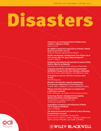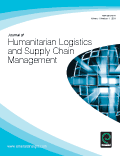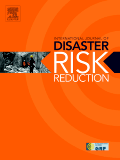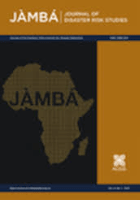
DISASTERS
Scope & Guideline
Illuminating the complexities of disasters across disciplines.
Introduction
Aims and Scopes
- Disaster Risk Management:
The journal emphasizes research on frameworks and strategies for managing disaster risks, including preparedness, response, recovery, and mitigation efforts. - Humanitarian Action and Ethics:
It explores the ethical dimensions of humanitarian aid, including the roles of various actors, power dynamics, and the implications of humanitarian interventions in crises. - Social Resilience and Community Engagement:
Research highlights the importance of community involvement and social capital in building resilience against disasters, emphasizing local knowledge and practices. - Impact of Climate Change and Environmental Factors:
The journal addresses how climate change and environmental degradation affect disaster vulnerability and the effectiveness of disaster management strategies. - Crisis Communication and Information Dissemination:
It focuses on the role of communication technologies and strategies in enhancing disaster preparedness and response, including the dissemination of vital information during emergencies. - Intersectionality and Vulnerability:
Research examines how various social identities (e.g., gender, ethnicity, socioeconomic status) intersect to influence vulnerability and resilience in disaster contexts.
Trending and Emerging
- Complex Emergencies and Multidimensional Crises:
There is an increasing focus on understanding complex emergencies that intertwine conflict, climate change, and public health crises, reflecting the need for integrated responses. - Localisation of Humanitarian Aid:
Research is trending towards the localisation of humanitarian efforts, emphasizing the need for empowering local actors and integrating community perspectives in disaster response. - Technological Innovations in Disaster Management:
Emerging studies are exploring the role of technology, including social media and data analytics, in enhancing disaster preparedness, response, and recovery efforts. - Mental Health and Well-being in Disaster Contexts:
The importance of mental health and psychosocial support in disaster recovery is increasingly recognized, with a focus on the well-being of both affected communities and humanitarian workers. - Climate Justice and Environmental Resilience:
Research is trending towards examining the intersection of climate justice and disaster resilience, highlighting the need for equitable approaches to climate adaptation and disaster risk reduction.
Declining or Waning
- Traditional Disaster Response Models:
Research centered on conventional top-down disaster response models is declining, as there is a growing recognition of the need for community-driven and participatory approaches. - Single-Hazard Focus:
There is a waning interest in studies that examine disasters in isolation, with a shift towards multi-hazard and systemic analyses that consider interconnected risks. - Historical Disaster Accounts:
The exploration of historical disasters as standalone subjects is becoming less prominent, as current research increasingly emphasizes contemporary and future-oriented disaster studies. - Aid Dependency and Critiques of Humanitarianism:
While still relevant, discussions surrounding aid dependency and critiques of humanitarianism appear less frequently as the focus shifts towards innovative and sustainable recovery practices. - Gender and Disaster Studies:
Although gender remains a critical theme, research explicitly focusing on gender roles in disaster contexts is not as prevalent, with broader discussions on intersectionality gaining prominence.
Similar Journals

Disaster Prevention and Management
Exploring multidisciplinary strategies for disaster management.Disaster Prevention and Management, published by Emerald Group Publishing Ltd, is a leading journal in the fields of disaster management, public health, and environmental policy. With an ISSN of 0965-3562 and an E-ISSN of 1758-6100, this journal has made significant contributions to both theoretical and practical advancements since its inception in 1992. Operating from the United Kingdom, it holds a Q2 ranking across various categories, including Business, Management and Accounting, Health (Social Science), and Public Health, reflecting its pivotal role in academic discourse and policy formulation. By engaging with contemporary issues related to disaster risk reduction, emergency preparedness, and resilience strategies, Disaster Prevention and Management aims to foster a multidisciplinary approach, making it a vital resource for researchers, practitioners, and students seeking to navigate the complexities of disaster scenarios effectively. With an impressive Scopus ranking across multiple categories, researchers are encouraged to explore its diverse range of articles and reports available for their academic and professional endeavors.

Journal of Humanitarian Logistics and Supply Chain Management
Championing efficiency in the face of disaster challenges.Journal of Humanitarian Logistics and Supply Chain Management is a premier academic journal published by Emerald Group Publishing Ltd that addresses the critical intersection of logistics and supply chain management within humanitarian contexts. With an ISSN of 2042-6747 and an E-ISSN of 2042-6755, this journal has established itself as a leading resource for researchers, professionals, and students dedicated to enhancing operational efficiency and effectiveness in disaster relief and humanitarian aid. The journal enjoys a distinguished standing with a Q1 ranking in Management Information Systems and a Q2 ranking in Management Science and Operations Research, reflecting its contributions to the field and its significant impact factor, placing it in the 75th percentile among its peers in Scopus rankings. Covering a spectrum of topics from innovative supply chain strategies to responsive logistics frameworks, the Journal of Humanitarian Logistics and Supply Chain Management provides valuable insights and practical solutions that are essential for enhancing resilience and responsiveness in humanitarian operations as it converges through the years from 2011 to 2024. Researchers and industry practitioners alike are encouraged to engage with its robust articles, fostering collaboration and knowledge exchange to meet the evolving challenges faced in humanitarian logistics.

Risk Hazards & Crisis in Public Policy
Driving research to mitigate risks in public policy.Risk Hazards & Crisis in Public Policy is a leading academic journal published by WILEY, focusing on the interdisciplinary study of risks and crises as they pertain to public policy. Since its inception in 2010, this journal has established itself prominently in the field, currently holding a Q2 quartile ranking in Public Administration and boasting an impressive Scopus percentile of 89, ranking it 24 out of 232 journals in its category. This demonstrates its significant influence and relevance among peer-reviewed publications. The journal serves as a critical platform for researchers, policymakers, and practitioners to share innovative research, insightful analyses, and practical solutions related to the management and mitigation of risks in public administration. Although it does not currently offer open access options, it continues to provide vital insights into burgeoning issues within the domain, making it an essential resource for anyone interested in advancing their understanding of risk management in public policy contexts.

NATURAL HAZARDS
Uncovering the complexities of environmental challenges.NATURAL HAZARDS is a premier academic journal published by SPRINGER that focuses on the multidimensional aspects of natural hazards, their impacts, and mitigation strategies. With a robust impact factor and esteemed rankings in reputable databases such as Scopus, this journal is classified in the Q2 category in Atmospheric Science and Q1 in both Earth and Planetary Sciences (miscellaneous) and Water Science and Technology, showcasing its influence in these critical fields. Established in 1988 and continuing through 2024, it serves as a vital resource for researchers, professionals, and students alike, providing cutting-edge research and insights into the dynamics of natural hazards. Although it does not offer open-access options, the journal is accessible through institutional subscriptions, ensuring that high-quality research is disseminated efficiently to those dedicated to advancing our understanding of environmental challenges. By publishing empirical studies, theoretical analyses, and case studies, NATURAL HAZARDS plays a crucial role in informing disaster management policies and strategies, thereby contributing to a safer, more resilient world.

Rivista di Psicologia dell Emergenza e dell Assistenza Umanitaria
Advancing Psychological Insights in Humanitarian CrisesRivista di Psicologia dell'Emergenza e dell'Assistenza Umanitaria is a distinguished academic journal published by FEDERAZIONE PSICOLOGI & POPOLI, dedicated to the emerging field of psychology in humanitarian assistance and crisis response. With an ISSN of 2280-9120, this Open Access journal has been providing invaluable insights since its inception in 2006, allowing researchers, professionals, and students unrestricted access to critical research and developments in the discipline. The journal serves as a vital platform for the dissemination of findings that address the psychological impact of emergencies and the effectiveness of psychological interventions in humanitarian contexts. Through rigorous peer-review and a commitment to advancing knowledge, the Rivista di Psicologia dell'Emergenza e dell'Assistenza Umanitaria stands at the forefront of its field, fostering collaboration and innovation among those dedicated to improving mental health outcomes in times of crisis.

Frontiers in Climate
Exploring the multifaceted impacts of climate change.Frontiers in Climate is a pioneering open-access journal published by FRONTIERS MEDIA SA, dedicated to advancing the understanding of climate science and its multifaceted impacts on the environment and society. Since its inception in 2019, the journal has established itself as a crucial platform for researchers and professionals, contributing significantly to fields such as atmospheric science, environmental policy, and pollution management, achieving commendable rankings within various categories. With an impressive quartile categorization of Q1 in Environmental Science (miscellaneous), Management, Monitoring, Policy and Law, and Pollution, as well as Q2 in Atmospheric Science and Global and Planetary Change for the year 2023, it reflects high-quality scholarly output and relevance in the academic community. The journal's commitment to open access ensures that vital research is accessible to all, fostering collaboration and innovation in tackling the pressing issues related to climate change. Whether you are a researcher, policymaker, or student, Frontiers in Climate is an essential resource for advancing knowledge and implementing solutions for a sustainable future.

Geoenvironmental Disasters
Uncovering insights into geoenvironmental hazards.Geoenvironmental Disasters, published by SPRINGERNATURE, is a leading open-access journal dedicated to advancing the interdisciplinary fields of environmental science, geography, and geotechnical engineering. Since its inception in 2014, the journal has made significant strides in disseminating high-quality research that addresses the challenges posed by geoenvironmental hazards and their impacts on society. With an impressive Q1 ranking across multiple categories, including Environmental Science (miscellaneous) and Geography, Planning and Development, it occupies a vital niche within the academic community. The journal’s rigorous peer-review process ensures that only the most insightful contributions are made available to a global audience. Researchers, professionals, and students are encouraged to engage with the content, which covers a wide range of topics, including disaster management, risk assessment, and stakeholder engagement in policy-making. This commitment to open-access accessibility since 2014 further enhances its reach and impact, providing a critical platform for advancing knowledge and innovation in managing geoenvironmental disasters.

Urbe-Revista Brasileira de Gestao Urbana
Exploring Interdisciplinary Insights in Urban ManagementUrbe-Revista Brasileira de Gestão Urbana is a prominent academic journal dedicated to the field of urban management and development, published by the esteemed Pontificia Universidade Catolica do Paraná (PUCPR). This open-access journal, actively disseminating knowledge since 2009, focuses on advancing awareness and understanding of urban planning, architecture, and geographical issues in Brazil and beyond. With an impressive impact reflected in its 2023 quartile rankings—Q2 in Architecture, Q3 in Geography, Planning and Development, and Q3 in Urban Studies—Urbe serves as a vital platform for researchers and professionals alike. The journal strives to foster interdisciplinary dialogue and provide valuable insights into contemporary urban challenges, making it an essential resource for those engaged in the study and practice of urban management. Scholars can access it freely, enhancing its reach and relevance in an increasingly interconnected world.

International Journal of Disaster Risk Reduction
Advancing resilience through innovative disaster risk strategies.The International Journal of Disaster Risk Reduction is a leading academic publication dedicated to advancing the understanding and management of disaster risks, promoting innovative solutions and effective strategies for risk reduction. Published by ELSEVIER, this journal serves as a critical platform for researchers, professionals, and students in the fields of Geology, Geotechnical Engineering, and Safety Research. With an impressive impact factor and ranked in the top quartile (Q1) across its various categories as of 2023, it demonstrates exceptional quality and relevance in its contributions to science and engineering disciplines. The journal has been committed to disseminating high-quality research since its inception in 2012 and remains open for new submissions through 2024. The Scopus rankings reflect its prestigious position, with notable placements in Earth and Planetary Sciences and Social Sciences, highlighting its influence in shaping best practices for disaster risk governance. As an essential resource for anyone involved in disaster preparedness and mitigation, the International Journal of Disaster Risk Reduction fosters knowledge exchange and collaboration among stakeholders in the global community.

Jamba-Journal of Disaster Risk Studies
Championing Safety through Collaborative Research.Jamba-Journal of Disaster Risk Studies, published by AOSIS, serves as a vital resource in the fields of management, monitoring, policy, law, and safety research, with an ISSN of 1996-1421 and an E-ISSN of 2072-845X. Since its establishment as an Open Access journal in 2006, Jamba has dedicated itself to disseminating high-quality research that informs and enhances disaster risk management practices, particularly within the South African context and beyond. With a robust Impact Factor and acknowledgement in the Q2 and Q3 quartiles across critical categories in 2023, Jamba ranks favorably in Scopus, notably Rank #50/109 in Social Sciences (Safety Research) and Rank #218/399 in Environmental Science (Management, Monitoring, Policy and Law). The journal's convergence over the years—from 2013 to 2024—signals its commitment to adapting contemporary challenges in disaster risk studies. Scholars and practitioners are encouraged to explore Jamba as a go-to platform for innovative insights and collaborative discussions that impact policy-making and practical applications in disaster risk reduction.